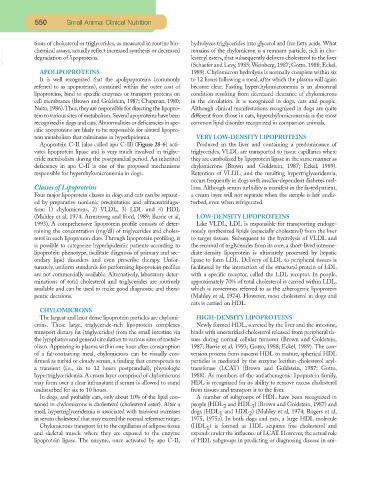Page 532 - Small Animal Clinical Nutrition 5th Edition
P. 532
550 Small Animal Clinical Nutrition
tions of cholesterol or triglycerides, as measured in routine bio- hydrolyzes triglycerides into glycerol and free fatty acids. What
VetBooks.ir chemical assays, actually reflect increased synthesis or decreased remains of the chylomicron is a remnant particle, rich in cho-
degradation of lipoproteins.
lesteryl esters, that subsequently delivers cholesterol to the liver
(Schaefer and Levy, 1985; Weinberg, 1987; Gotto, 1988; Eckel,
APOLIPOPROTEINS 1989). Chylomicron hydrolysis is normally complete within six
It is well recognized that the apolipoproteins (commonly to 12 hours following a meal, after which the plasma will again
referred to as apoproteins), contained within the outer coat of become clear. Fasting hyperchylomicronemia is an abnormal
lipoproteins, bind to specific enzymes or transport proteins on condition resulting from decreased clearance of chylomicrons
cell membranes (Brown and Goldstein, 1987; Chapman, 1980; in the circulation. It is recognized in dogs, cats and people.
Naito,1986).Thus,they are responsible for directing the lipopro- Although clinical manifestations recognized in dogs are quite
tein to various sites of metabolism.Several apoproteins have been different from those in cats, hyperchylomicronemia is the most
recognized in dogs and cats.Abnormalities or deficiencies in spe- common lipid disorder recognized in companion animals.
cific apoproteins are likely to be responsible for altered lipopro-
tein metabolism that culminates in hyperlipidemia. VERY LOW-DENSITY LIPOPROTEINS
Apoprotein C-II (also called apo C-II) (Figure 28-6) acti- Produced in the liver and containing a predominance of
vates lipoprotein lipase and is very much involved in triglyc- triglycerides, VLDL are transported to tissue capillaries where
eride metabolism during the postprandial period. An inherited they are catabolized by lipoprotein lipase in the same manner as
deficiency in apo C-II is one of the proposed mechanisms chylomicrons (Brown and Goldstein, 1987; Eckel, 1989).
responsible for hyperchylomicronemia in dogs. Retention of VLDL, and the resulting hypertriglyceridemia,
occurs frequently in dogs with insulin-dependent diabetes mel-
Classes of Lipoproteins litus.Although serum turbidity is manifest in the fasted patient,
Four major lipoprotein classes in dogs and cats can be separat- a cream layer will not separate when the sample is left undis-
ed by preparative nonionic precipitation and ultracentrifuga- turbed, even when refrigerated.
tion: 1) chylomicrons, 2) VLDL, 3) LDL and 4) HDL
(Mahley et al, 1974; Armstrong and Ford, 1989; Barrie et al, LOW-DENSITY LIPOPROTEINS
1993). A comprehensive lipoprotein profile consists of deter- Like VLDL, LDL is responsible for transporting endoge-
mining the concentration (mg/dl) of triglycerides and choles- nously synthesized lipids (especially cholesterol) from the liver
terol in each lipoprotein class. Through lipoprotein profiling, it to target tissues. Subsequent to the hydrolysis of VLDL and
is possible to categorize hyperlipidemic patients according to the removal of triglycerides from its core, a short-lived interme-
lipoprotein phenotype, facilitate diagnosis of primary and sec- diate-density lipoprotein is ultimately processed by hepatic
ondary lipid disorders and even prescribe therapy. Unfor- lipase to form LDL. Delivery of LDL to peripheral tissues is
tunately, uniform standards for performing lipoprotein profiles facilitated by the interaction of the structural protein of LDL
are not commercially available. Alternatively, laboratory deter- with a specific receptor, called the LDL receptor. In people,
minations of total cholesterol and triglycerides are routinely approximately 70% of total cholesterol is carried within LDL,
available and can be used to make good diagnostic and thera- which is sometimes referred to as the atherogenic lipoprotein
peutic decisions. (Mahley et al, 1974). However, most cholesterol in dogs and
cats is carried on HDL.
CHYLOMICRONS
The largest and least dense lipoprotein particles are chylomi- HIGH-DENSITY LIPOPROTEINS
crons. These large, triglyceride-rich lipoprotein complexes Newly formed HDL, secreted by the liver and the intestine,
transport dietary fat (triglycerides) from the small intestine via binds with unesterified cholesterol released from peripheral tis-
the lymphatics and general circulation to various sites of metab- sues during normal cellular turnover (Brown and Goldstein,
olism. Appearing in plasma within one hour after consumption 1987; Barrie et al, 1993; Gotto, 1988; Eckel, 1989). The con-
of a fat-containing meal, chylomicrons can be visually con- version process from nascent HDL to mature, spherical HDL
firmed as turbid or cloudy serum, a finding that corresponds to particles is mediated by the enzyme lecithin-cholesterol acyl-
a transient (i.e., six to 12 hours postprandial), physiologic transferase (LCAT) (Brown and Goldstein, 1987; Gotto,
hypertriglyceridemia. A cream layer comprised of chylomicrons 1988). As members of the antiatherogenic lipoprotein family,
may form over a clear infranatant if serum is allowed to stand HDL is recognized for its ability to remove excess cholesterol
undisturbed for six to 10 hours. from tissues and transport it to the liver.
In dogs, and probably cats, only about 10% of the lipid con- A number of subgroups of HDL have been recognized in
tained in chylomicrons is cholesterol (cholesterol ester). After a people (HDL and HDL ) (Brown and Goldstein, 1987) and
2
3
meal, hypertriglyceridemia is associated with transient increases dogs (HDL and HDL ) (Mahley et al, 1974; Rogers et al,
2
1
in serum cholesterol that may exceed the normal reference range. 1975, 1975a). In both dogs and cats, a large HDL molecule
Chylomicrons transport fat to the capillaries of adipose tissue (HDL ) is formed as HDL acquires free cholesterol and
1
and skeletal muscle where they are exposed to the enzyme expands under the influence of LCAT. However, the actual role
lipoprotein lipase. The enzyme, once activated by apo C-II, of HDL subgroups in predicting or diagnosing disease in ani-

